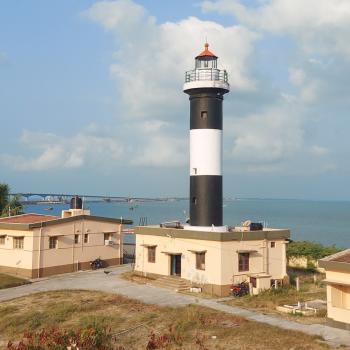Pamban Lighthouse

Ships traveling from Indian West coast to the East coast or back have to encircle Sri Lanka and for this they waste lot of time and fuel. Sethusamudram Project for deepening the Pamban channel that connects Bay of Bengal with Arabian Sea, to enable ships to pass the channel, is still to come. Centuries back when the watercrafts were smaller and the channel was deeper, ships were passing through the channel and there was a port at Pamban.
In the end of the thirteenth century, Marco Polo had taken this route to visit Kollam during his stay with Chinese Emperor Kublai Khan. In 1840, British tried to dredge this channel and deepen it for shipping. Bucket dredgers and Spoon dredgers were used to deepen the channel and several hundreds of convicted prisoners were forced to work like bonded labour, under the supervision of Military men. Vessels of a greater draught than 14 feet never visited the port then.
Along with development activities at Pamban port, a Lighthouse was proposed in 1841 and a small hillock near the port was selected to erect the light. In the ensuing years, a 41-foot-high brick and lime tower, 9 feet diameter and round in shape was erected at a cost of Rupees 536/-. The light with a lantern constructed at Gun Carriage manufactory under the Military at Madras, was commissioned on 21st April 1846.
The fixed white light shown from the brownish tower, visible from a distance of 10 miles, was 84 feet above the high water level. Four coconut oil wick lamps arranged in right angles with each other were the illuminants and the parabolic reflectors placed behind these lamps improved the efficiency of light. Two Light keepers were engaged to tend the lamps and the Sea Customs officer of Pamban was the In-charge of operations.
In 1860, a new Dioptric light was proposed, and before erecting the new lighting apparatus, 15 feet height was added to the existing tower to augment the total height from base to vane as 72 feet. The light from the 4th order Dioptric apparatus was shown at a height of 97 feet above sea level. Additional three Light Keepers were posted at Pamban in 1874, raising the total number to 5.
In 1895, Mr. F.W. Ashpitel, an Executive Engineer working for Marine Department recommended for extensive repairs to the Pamban tower. He recommended retaining the height of Lighthouse tower and continuing with the existing lighting apparatus. Accordingly, Superintending Engineer of P.W.D was asked to prepare a plan and estimate for the alterations to the tower. There was a delay in follow-up actions and in year 1900, Government had to remind P.W.D for early submission of plan and estimate and in the same letter, Government advised P.W.D. to submit an estimate for converting the light from fixed to occulting.
Pamban light was extinguished on 1st October 1900 to re-exhibit on 1st March 1902 after rebuilding of tower and altering light to occulting. A temporary light was exhibited from the same tower, during the period of modifications. An occulting mechanism was incorporated inside the existing optic and the character of new light was group occulting in one minute, showing groups of four eclipses of four and a half seconds duration each, separated by intervals of 7 seconds and followed by an interval of twenty one seconds. The light was improved in 1923 by installing an acetylene gas flasher inside a 300 mm drum optic with a range of 14 miles and the character of new light was three quick flashes every nine seconds. The tower was painted white during the modification to identify it in daylight, and the new light was commissioned on 31st March 1923.
After commissioning of new lighting apparatus, the Lighthouse was declared as ‘Unattended’ and Light Keepers were withdrawn. After conversion of light as occulting, the light was being maintained by a Head Light Keeper and an Assistant Light Keeper.
Pamban Lighthouse maintained by Tamil Nadu State Port Department since Indian Independence was taken over by The Directorate General of Lighthouses and Lightships on 3rd March 2004. The gas flasher was discontinued and an electronic flasher with a 300 W halogen lamp as illuminant was introduced from 03.03.2004 and the character of present light is single flash in 5 seconds.
At present, “Sabik” make, LED 160 HW Model, LED Flasher having maximum Power consumption of 40 W is in use with the character of Single flash in every 5 seconds.
Master Ledger of Pamban Lighthouse(336.76 KB) Click here for Main Website
Click here for Main Website










